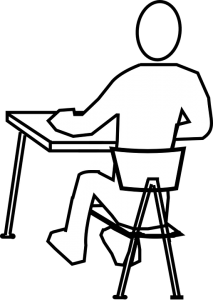Lazy habits at work
Do you take the time to make sure you are sitting in the correct position in your office chair?
The chances are you don’t.
After all, it is easy to get into a routine of unhelpful habits. You might moan that your lower-back aches. Or you might find yourself feeling overly drowsy late in the afternoon. However, you fail to attribute all this to poor posture.
But making just a few adjustments can make a big difference to how you feel on a daily basis. Let’s find out why.
What is the correct sitting position?
The goal of sitting correctly is to minimise the stress and strain on muscles and joints. Also, to allow good circulation and a relaxed posture that allows you to breathe normally.
To help facilitate this there are certain things you should aim to do.
- Aim to keep your feet flat on the floor
- Have your chair at a height that allows your thighs to be parallel to the floor
- In addition, let the arms rest flat with wrists straight (not cocked at an angle)
- Ensure the top of the screen is at eye-level to keep the head in a balanced position
- Crucially, make sure the base of the spine is properly supported.
These are some of the most important pointers. But the list is not exhaustive. A good DSE (Display Screen Equipment) assessment will cover everything you need to know.
If you are not familiar with DSE regulations, it is worth taking time to look into it. They do a lot to safeguard employees rights to a functional workspace.
As a side note, all Perea Clinic staff are DSE qualified. So if you want professional assessments done at your workplace, don’t hesitate to contact us.
The harmful effects of poor posture at work
Generally speaking, we don’t always take action on something until it is too late. But, in fact, it is vital that you take proper measures to ensure you are sitting in the correct position in your chair.
All things considered, you spend a big slice of time sat at your desk. And lazy posture can certainly take its toll. Some harmful effects may come as little surprise. You might expect that you could get a tight lower back or neckache.
But there are many other possible side effects to poor posture including,
- Increased likelihood of headaches.
- Greater fatigue, and problems sleeping.
- Issues with joint pain and a greater possibility of arthritis long term.
- Digestive problems.
- Elevated levels of stress.
When you reflect on that little list, it’s time to raise your awareness of how you sit.
So, what can you do?
The first step is to be more aware of how you habitually sit. The next step is to take the time to change your work environment. Insist on having a DSE assessment if you haven’t already had one.
But don’t just do it as a one-off thing. Set up prompts around your desk to ensure you are regularly sitting in the correct position.
It may feel a little unnatural at first. But as you start to form a new habit, your body will start to thank you for it. And you should feel a lot fresher at the end of the day.
If you need advice or have any questions about our treatments, please contact us. You can find us in Mill Hill Broadway and Islington. We are always happy to help.
We hope this information is useful. If you like it, please share!




